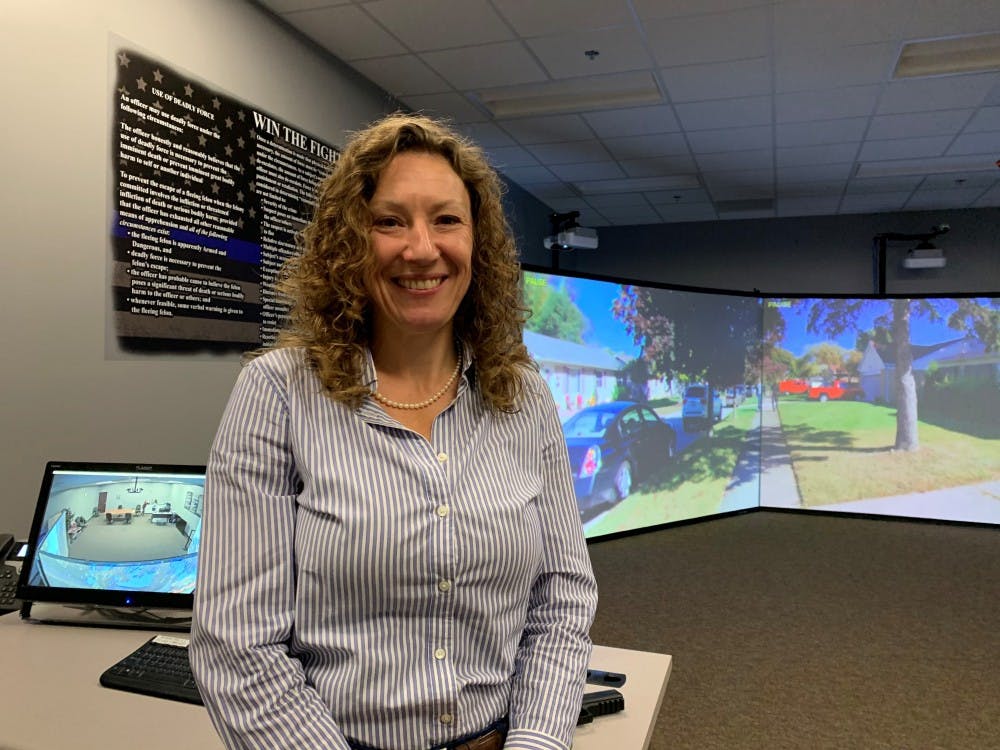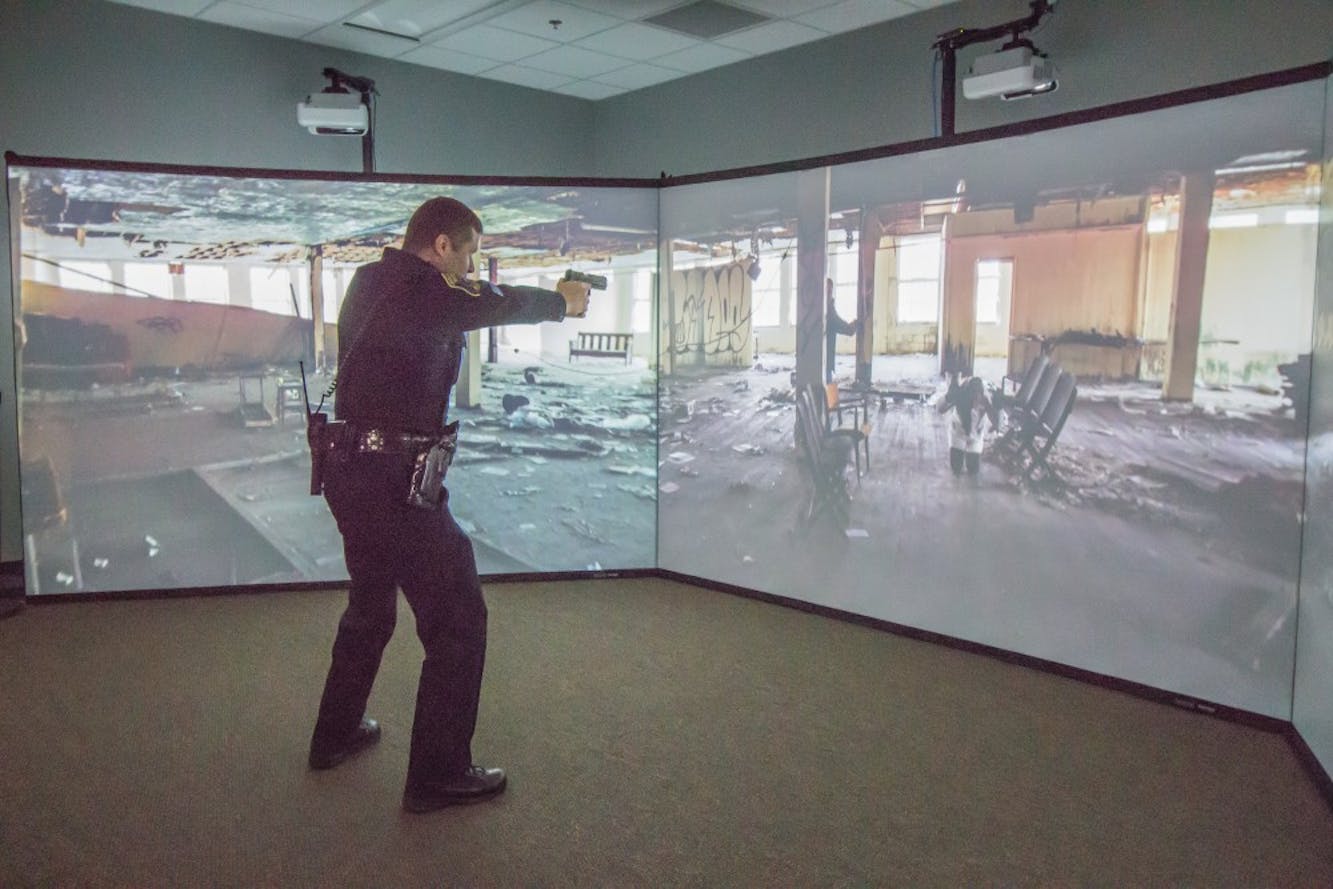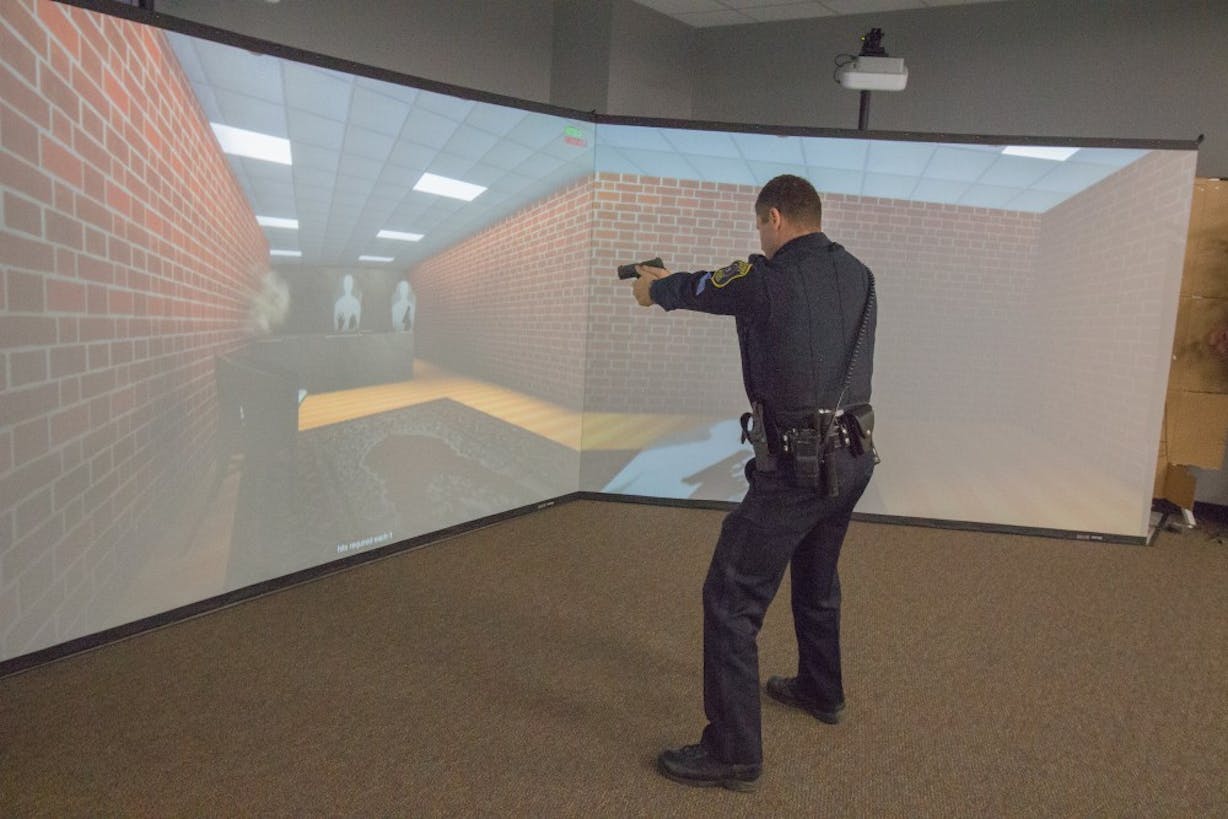Doctorate student researches how police can de-escalate instead of using lethal force

Central Michigan University doctorate student Joy VerPlanck is hoping to make law enforcement smarter, safer and more creative – one police officer at a time.
Through CMU’s Doctorate of Educational Technology Program, VerPlanck, 45, is studying how police train to think more creatively to de-escalate tricky situations.
For her doctorate thesis, the Waterloo Township student is researching how law enforcement agencies can use educational technology, such as situational simulators, to think more creatively instead of immediately responding with lethal force.
CMU Police Department is one of hundreds of law enforcement agencies across the country that use a situational simulator called Multiple Interactive Learning Objectives (MILO) for training. The MILO training system uses interactive video scenarios to prepare officers to identify, process and comprehend information about how to respond to any situation.

Sgt. Trent Case uses the MILO Range Oct. 21 in the Combined Services Building.
While officers can use training weapons such as handguns, rifles and shotguns in the simulation, VerPlanck is specifically studying how officers de-escalate each situation instead of turning to more lethal options.
“We’re trying to use (the MILO) to teach people to take control of a situation, de-escalate it, and use the least force required in a situation,” VerPlanck said. “If no force is required, that’s a win-win for everybody. If they have to use force, this simulator will make them proficient at it.”
As VerPlanck studies officers using the simulations, she's hoping to determine how law enforcement officers can use simulation technology to increase their cognitive load capacity, which is essentially the capacity someone has in order to take in different distractions at one time.
“We have to try to figure out how we’re going to use this amazing technology to increase the cognitive load capacity, which will free up the part of the brain for the officer to use it for more creative thought processes," she said.
Evolution of police training
VerPlanck is not new to training with simulators – she herself was trained with one. When she was trained as a military police officer in 1997, she was first introduced to a single-screen training simulator, which was brand new at the time.
However, she said police training was done a lot differently back then than it is today. She described it as a “bureaucratic training process” in the military, with no focus on differential learning.
“They just didn’t spend a lot of time working on creative thinking with young police officers,” she said. “It was, ‘We’re going to teach you everything you need to know in a short amount of time, and then we’ll send you off and the rest you’ll learn from experience.’”
Over the past few decades, law enforcement training has changed, she said, as officers today must think more creatively than they did in the past.
“Thirty years ago, we wouldn't have thought to look in someone’s shoe for a bomb. We wouldn't have had to deal with the distractions of someone coming up to you and recording you with their phone,” she said.
“We have to train differently, and we have to train to recognize that threats are becoming more creative, so our responses can’t just be anticipating that something’s always going to look the same.”
Because VerPlanck understands the training that many law enforcement officers go through, she is able to use her police background in her own research to understand that not all officers are trained to think creatively.
“I understand that some of these small police departments don’t have someone trained in instructional theory,” she said. “All they have are these MILO systems and I’d like to provide research to help make them even more effective.”
The bigger picture
Across the country today, many police departments are under national scrutiny as some citizens question the ways that police use lethal force and whether they target unarmed minorities. In many cities, the relationship between police and citizens is tumultuous as the public begins to question the tactics used by police.
VerPlanck said she is aware of the national setting of her research – that oftentimes, police officers are viewed negatively due to nationwide tension.
But with that national setting, VerPlanck hopes her research will help law enforcement use educational technology to think more creatively to de-escalate those kinds of situations instead of responding with force.
“I hope the result of the research improves their ability to use the technology effectively to become better communicators, better creative thinkers, more effective and safer in their job,” she said. “The result of that will always be a better relationship with the community.”
Still a ways to go
VerPlanck has completed all of her academic requirements for CMU’s Doctor of Educational Technology program, and she is now focusing on her dissertation. After having spent the past year reviewing literature, she’s found some of the gaps in existing research where she will be able to expand.
“One of the challenges with doctoral-level research is there has to be enough existing research to show that there’s something worth studying, but not so much that you’re being redundant,” she said. “It’s a difficult fine line.”
While she’s found plenty of research on cognitive load theory, law enforcement usage of simulators, and using simulators for creative thinking, she hasn’t found any research specifically tying creative thinking and law enforcement with cognitive load theory – the gap that she’s been looking for.
After developing her hypothesis and methods, she’s now in the phase of conducting her research. After having completed her study with CMU police officers, she’s now looking for other willing police departments who can take part in her research.
Because she works in Ann Arbor, she’s hoping to find additional police departments in that area who will participate in her research. Luckily for her, she works for MILO – giving her unlimited access to the educational simulator for her studies.
While VerPlanck hopes to graduate in May, the timeline for her research is mostly dependent upon the willingness of the police departments that she studies.
“My timeline is dependent on chief support – I’m kind of at their mercy so I have to be willing to travel to gather my data,” she said. “Some chiefs may be hesitant to participate because they may not want to share training records. Chief Klaus has been very supportive of the whole process, and I’m so grateful to him and the CMUPD team.”

Sgt. Trent Case uses the MILO Range Oct. 21 in the Combined Services Building.
VerPlanck said CMU police have been extremely supportive in taking part in her research.
“I think they’re being so supportive because I am a CMU student, I’m kind of one of their own,” she said.
Lt. Cameron Wassman, of CMUPD, said the university police department was eager to jump on board with VerPlanck’s research.
“We work at an educational institution. But we don’t often get the opportunity to participate in education every day,” he said. “This is a unique opportunity for us to get involved with the educational process.”
VerPlanck said she picked CMU specifically because of its DET program, and it has already exceeded all of her expectations.
“The staff has been so supportive, and they’ve been genuinely excited about my research as well,” she said. “I love being a CMU student, it’s been great.”






